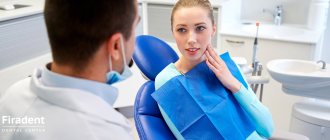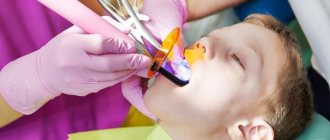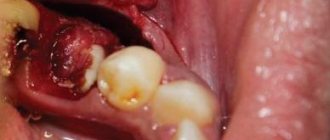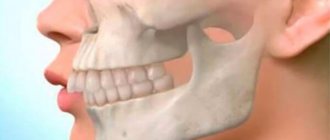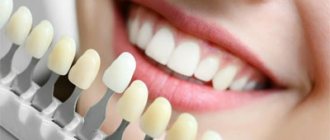Dentistry is a completely self-sufficient branch of medicine. Today dentistry is able to eliminate any problem of the dental system. Depending on the clinical situation, the patient is referred to the appropriate specialist:
- Dentist-therapist. Restoration of damaged teeth and enamel, treatment of caries, pulpitis, periodontitis, gum disease.
- Orthodontist. Bite correction.
- Orthopedist. Modern prosthetic techniques.
- Dentist-surgeon. Complex therapy requiring surgical intervention. Including implantation.
Aesthetic dentistry (restoration) is also popular, which helps to get rid of defects in teeth (chips, cracks), curvature of the dentition, damage to teeth (luxation, trauma), and pathologies of both jaws.
Brutal drills and anesthesia with side effects lasting a week are long gone. Modern methods of dental treatment are based on the use of computer technology, non-invasive therapy, professional equipment and innovative materials. This tandem allows you to carry out a complex procedure that previously took months, in just a couple of visits to the dentist. High quality and pain free.
Elimination of caries
Modern methods of caries treatment are based on non-invasive therapy, even in the most advanced cases. Often, a drill or traumatic surgical intervention is not required to remove a carious cavity.
The use of a laser is considered a revolutionary technique. The device copes well with removing damaged tooth tissue. And at the same time disinfects the treated area. For surgical operations, the laser is also indispensable, because makes neat, local cuts. This reduces the traumatic nature of the procedure and, as a consequence, the rehabilitation period.
For the treatment of caries in the initial stages, the ozone therapy procedure is effective. Ozone treatment helps get rid of any infection in the oral cavity and prevents the further spread of bacteria. Ozone is used for superficial and fissure caries. And also when the enamel darkens, when bacteria have not yet reached the dentin. The procedure is safe, painless, and is often used in pediatric dentistry.
Air blasting is also used to remove dead tooth tissue. A directed stream of fine particles helps clean the affected tooth cavity, without the use of a drill.
Bite correction
The beauty of a smile is influenced by both the whiteness of the teeth and the bite. In addition, due to the uneven distribution of the load on the teeth, malocclusion can cause serious periodontal diseases. Also, with an incorrect bite, the conditions for brushing teeth worsen, which can become one of the causes of caries. An incorrect bite makes it difficult to chew food , which can lead to diseases of the digestive system.
It is possible to correct the bite both in childhood and in adulthood. Although in adulthood this procedure has some peculiarities. Thus, getting rid of malocclusion in adults takes longer, and before treating the bite, you need to get rid of inflammatory diseases of the mouth.
permanent braces are used to treat malocclusion in adults . They are special brackets that are secured with glue to the tooth enamel. Braces systems are selected for each patient individually, which ensures wearing comfort. Now these systems are made of ceramics, which does not differ in color from enamel, or from transparent materials, which makes such systems invisible to people around them.
silicone aligners can be used to treat simple cases of malocclusion . Such mouthguards do not cause discomfort and are invisible to strangers. Orthodontic plates are used to realign the jaw bones and help break bad chewing habits. For minor malocclusions, trainers are used.
In case of severe malocclusion and incorrect position of the jaw bones, surgical intervention is necessary. Very good results can be obtained by combining the two methods, when correction with braces is performed after surgery.
Gum inflammation
Common gum diseases are gingivitis and periodontitis. In the first case, inflammation develops only in soft tissues and does not affect the dental unit. Characterized by swelling, redness and bleeding of the gums. If you do not seek dental care, gingivitis can become chronic. Or develop into periodontitis. This involves the root canals and hard tissues of the tooth. The adjacent gum peels off, and a purulent process begins in the resulting cavity. Without timely treatment of teeth, this leads to their loosening and loss.
The choice of therapeutic methods is based on the condition of the oral cavity and the severity of the pathology. As a rule, the following are used for the prevention and treatment of gum inflammation:
- Rinse procedures. After the examination, the doctor prescribes the optimal type of solution (alcohol-based antiseptics or with the addition of chlorhexidine).
- Ointments and gels (healing, anti-inflammatory, antifungal).
- Therapeutic toothpastes (anticaries, antiseptic).
- Medicines.
In most cases, soft tissue inflammation is caused by a poorly installed (polished) filling or crown. Therefore, when a disease appears, it is important not to delay visiting a doctor.
Physiotherapy (electrophoresis, darsonval, massage) is used as additional methods for treating soft tissue diseases in the oral cavity.
Complex treatment
The Dentospas clinic employs dentists specializing in the fields of therapy, surgery, hygienics, periodontology, orthodontics, and implantology. If a patient is diagnosed with various dental health problems (for example, adentia in combination with gum disease or caries in combination with malocclusion), the doctor arranges a course of action to solve them in the optimal way. It is possible to involve doctors of a narrow specialization (implantologist, orthodontist), but at the same time the actions of specialists remain coordinated, and different problems are solved so that treatment plans complement and improve each other.
Advantages of this approach:
- Each of the patient's problems is solved systematically. He receives high-quality care, a predictable result of therapy;
- treatment is organized in an optimal way: the correct sequence of actions is built, the number of visits is reduced to a minimum, the time frame is reduced, etc.;
- The patient undergoes a comprehensive diagnosis and provides test results and health data once. He does not need to be fully examined every time a new stage of treatment begins or when the dentist moves on to the next problem.
A systematic approach to solving dental problems does not mean that all treatment will be performed at once, at the same time. On the contrary, it allows you to plan the necessary procedures and distribute them over time. They are performed on a schedule convenient for the patient, with an optimal distribution of costs for him.
Inflammation of the dental nerve and hard tissues of the tooth
The dental nerve (pulp) is located in the internal cavity of the tooth and contributes to the development and strengthening of the hard tissues of the tooth. Any impact, mechanical or due to infection, can cause inflammation of the nerve. In the acute stage, pulpitis is accompanied by severe pain in the tooth, especially at night. Chronic pathology does not have pronounced symptoms, pain syndrome appears periodically.
Therapy depends on the degree of damage to the pulp tissue. If the inflammation is minor, the dentist fixes the drug in the tooth. Until the disease is completely eliminated. The tooth is then filled. If the dental nerve is completely affected, the pulp is first removed under anesthesia. The dental treatment procedure includes cleaning and filling the canals. Then restoration of the upper, crown part of the tooth.
An advanced form of pulpitis provokes the development of periodontitis – inflammation of the upper part of the tooth root. The main symptoms are sharp pain when pressing on the tooth, swelling of the adjacent gums. It also occurs in acute and chronic stages. Therapy includes the procedure of depulpation and subsequent filling of the canals. If a cyst is present, in some cases an incision is made in the gum and the affected apex of the tooth root is resected.
Enamel destruction
Pathology is usually caused by a carious process. Bacteria in the oral cavity disrupt the acid-base balance, which changes the composition of the enamel. The cause of demineralization can be an incorrect diet when there is a deficiency of calcium, phosphorus and fluorine in the body. And also due to chronic diseases associated with inability to absorb calcium and metabolic disorders.
The destruction of the tooth surface can be stopped by a remineralization procedure. But only if the hard tissues of the tooth are not damaged. That is, caries is at the initial stage.
The dental treatment procedure includes:
- Professional cleaning, removing soft and hard plaque.
- Treatment of the surface of teeth with special compounds containing calcium (8-10%).
- Installation of a temporary mouth guard with therapeutic gel (sodium fluoride, calcium hydroxide).
The course of enamel restoration includes 7-10 sessions, depending on the condition of the teeth. The procedure takes no more than half an hour, is absolutely safe and painless.
Services
| Service | Price |
| Application anesthesia | 150 rub. |
| Infiltration/conduction anesthesia | 350/450 rub. |
| Sight image on a radiovisiograph | 350 rub. |
| Panoramic photo of OPTG | RUB 1,300 |
| Removing an old filling, preparing a carious cavity | 500 rub |
| Placing a temporary filling (“Septopack”, France) | 500 rub |
| Placement of a therapeutic/isolating pad (“Dycal”/“Ionosit”, USA) | 250/350 rub. |
| Light-curing filling (“Filtek ultimate”, USA) 1 surface | RUB 1,750 |
| Light-curing filling (“Filtek ultimate”, USA) 2 surfaces | RUB 2,750 |
| Light-curing filling (“Filtek ultimate”, USA) 3 surfaces | RUR 3,750 |
| Tooth restoration under a crown (“Filtek ultimate”, USA) | RUB 4,250 |
| Artistic tooth restoration (“Filtek ultimate”, USA) | 6,500 rub. |
| Fissure sealing (“Filtek flow”, USA) | RUB 1,500 |
| Installation of fiberglass pin (Switzerland) | 3,000 rub. |
Treatment of diseased teeth is a necessity that every person faces nowadays, because a healthy smile is valued at all times and is an indicator of a person’s status. Oral diseases also affect the health of the digestive system.
The most common causes of oral diseases are poor environment, tasty but unhealthy food, and poor quality of drinking water. Therefore, in order to preserve teeth , you need to practice oral hygiene and eat food rich in minerals that are involved in the regeneration of dental tissue. You should also have regular check-ups with your doctor in order to identify problems in a timely manner. Heredity has a huge impact on dental health.
Tooth sensitivity
A painful reaction to temperature changes, or due to chemical exposure is called hyperesthesia. The cause is increased abrasion of the enamel and the presence of pathological inflammation of the soft tissues in the oral cavity.
In this case, dental treatment is based on eliminating the root cause of the disease: treating inflammation, removing low-quality or broken fillings, closing the roots of the tooth due to receding gums.
The procedure consists of daily remineralization, as well as the use of physiotherapy. Typically, it takes about two weeks for tooth enamel to restore. The patient then continues therapy at home.
Root canals
In dentistry, restoring the inside of a tooth is called endodontic treatment. It is required to preserve the dental unit during the treatment of deep stages of caries, as well as in the prosthetic procedure.
The therapy consists of preliminary extraction of the pulp, thorough cleaning and disinfection of the canals, followed by filling them. This is necessary to protect the resulting healthy tooth cavities from the penetration of bacteria. After filling the canals, the dentist restores the upper, crown part of the tooth.
If the inflammatory process has spread to the root of the tooth, then a drug is fixed before filling.
Air sanding
In modern dentistry, there are different ways to replace the drill when treating affected areas of the teeth before installing a filling. One of them is the use of air to grind the tooth surface (microabrasive processing). With air, microscopic abrasive particles are supplied to it, which grind the tooth, removing the affected parts of the tissue. The method is characterized by high precision directed air flow, which helps protect nearby tissues from damage. This method is recommended for use in the early stages of caries.
Innovative painkillers
Dental restoration using general anesthesia is a thing of the past. Modern anesthesia is applied locally and does not cause side effects.
The most popular option is sedation. An anesthetic in which the patient is conscious but does not feel pain during surgery. New types of anesthesia also act as a sedative to reduce patient anxiety during the procedure.
Modern types of painkillers are effective for no more than 1.5-2 hours. After which the patient returns to his normal life, without problems with health.
Dental treatment in our dentistry: advantages
In our clinic, experienced specialists take care of your teeth. Contact us and high-quality modern dentistry will come to your aid! Our advantages are:
- professional equipment. We have Sirona X-ray equipment for targeted images; devices for orthopantomography, teleradiography; multislice computed tomograph, equipment for MRI, ultrasound of the salivary glands, photometric examination of hidden carious cavities, condylography. For better visibility, high precision of the dentist’s actions and reduction of trauma, the clinic uses binocular glasses and motorized dental microscopes from Carl Zeiss and KaVo. Professional and modern equipment of the dental department of JSC "Medicine" (clinic of academician Roitberg) allows our employees to make correct diagnoses, as well as provide dental treatment at a high level;
- qualified personnel. Our employees use innovative therapeutic and surgical techniques in dentistry. They regularly study both in Russia and abroad. Our staff includes doctors with extensive clinical experience, including candidates and doctors of medical sciences;
- painlessness. We take into account not only the anatomical features of the patient, but also provide him with comfort. We will select the right anesthesia and also do everything for your psychological peace of mind.
To clarify the price of dental treatment, contact the administrator of JSC “Medicine” (clinic of academician Roitberg) and make an appointment with a therapist or an appointment. To do this, call by phone in Moscow or use the provided electronic form.
It’s easy to come to us for diagnosis and treatment! Our dentistry is located in the center of the Russian capital. It is equally convenient to get to from the Mayakovskaya, Tverskaya and Belorusskaya metro stations.
